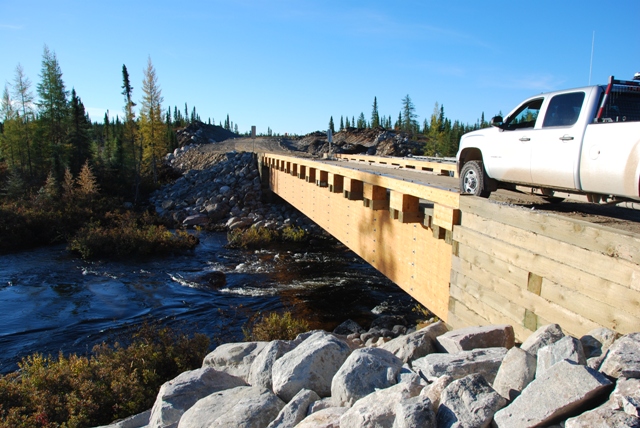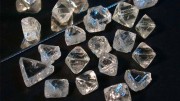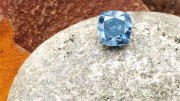For diamond junior Stornoway Diamond (TSX: SWY), going it alone at its Renard development project in Quebec has come with its challenges.
Having to contend with terrible equity markets while trying to build a mine is one of them.
But while the diamond sector has struggled to attract investment for several years, Stornoway president and CEO Matt Manson says he’s seen a lot more interest in diamonds lately.
“Twelve months ago, it was very hard to get a marketing meeting if you’re a diamond story with an institutional investor, and now it’s much more interesting,” he told Diamonds in Canada in mid-October.
“All of the excitement around the BHP Billiton and the Rio Tinto sales processes created a lot of renewed interest,” Manson continued. “That was the first time it was possible to buy large-scale producing assets in the diamond sector, so that brought a lot of specialized, private equity-type money into the sector — but also general investor interest.”
Manson is hoping that interest will allow him to nail down a financing deal for Renard in time to start construction before the end of the year. That would keep the project on schedule to begin commercial production in mid-2016.
“We’re right in the thick of the heaviest-lifting part of the project financing process right now,” Manson said in October.
Funding aside, everything else Stornoway needs to move Renard ahead is already in place. The company received a certificate of authorization, the major mining permit needed to start construction, in December 2012, and signed impact benefit agreements with the Cree Nation of Mistissini and the Grand Council of the Crees in March of 2012. More recently, while it’s still under construction, all segments of the Highway 167 extension that will make Renard the only diamond mine with all-weather road access in Canada, were connected in September.
Located in the Otish Mountains region of north-central Quebec, Renard will cost around $755 million to build, although Stornoway will need to raise a little more than that to cover working capital and cost-overrun facilities.
Manson anticipates the financing will be 50% debt and 50% equity, and may also include forward sales, streaming or a royalty deal to fill in any gaps and reduce the equity component.
The company has seven lenders in syndicate for a debt deal that will be in the $400-million range — the biggest ever project financing deal for a diamond mine operated by a junior, Manson says, and possibly for any diamond mine period.
But he says it’s the equity portion of the financing that has been the biggest challenge for Stornoway.
Manson, who was an executive with Aber Resources (now Dominion Diamond [TSX: DDC; NYSE-DDC]), says that when Aber was at the same point of development and trying to finance its 40% stake in the Diavik mine, it traded at 2 or 2.5 times its net asset value (NAV).
Stornoway, however, is trading at 0.2 or 0.3 times NAV. So while Aber could raise equity easily but had more difficulty with debt, Stornoway finds itself in the reverse situation.
“Renard and Diavik actually, from the point of view of the feasibility studies, are not dissimilar projects,” Manson says. “In fact, I’d argue that Renard has many advantages. It has a smaller capex, the capex buys you the whole 20-year mine life, we have a road, so we can control our opex better, and we have more resource upside than Diavik ever had. Diavik is done at the end of its 20 years, and we expect to go further than that (at Renard).
Diavik’s higher capex of $1.3 billion only paid for the plant and the first four or five years of operation, Manson notes.
Once the equity portion of the financing is finalized, the debt and equity portions will be announced as part of one comprehensive financing package because in this market, “nobody wants to be the first money in,” Manson says.
To give it some time and flexibility while it continues to hammer out the details, in early October, Stornoway announced a bridge loan for up to $20 million with Ressources Québec, a subsidiary of the provincial agency Investissement Québec (IQ).
IQ recently merged with Société génerale de financement du Québec, which was a 50% partner in Renard before Stornoway bought it out last year. The transaction made IQ Stornoway’s largest shareholder, and committed IQ to providing $100 million in project financing.
So, while Stornoway doesn’t have a major company as a partner, it does have a partner of sorts in the Quebec government. Quebec’s reputation as a top jurisdiction for mining, however, has taken a hit recently. The previous Liberal government raised taxes on miners over 2011-12, and the new Parti Quebecois government, elected in 2012, planned to do so again in 2014. The industry has been saved from the impending tax hike by the PQ’s minority status: it could not get opposition support for its new royalty scheme, so it was scrapped in late October.
The PQ government has also pulled back on the previous government’s commitment to build a 240-km extension of Highway 167 from Chibougamau up to Renard (with some financial help from Stornoway). Instead, under a new agreement, Quebec’s transportation ministry provided the company with a $77-million loan to complete the northern 97 km of the road itself.
In Stornoway’s contractors hands, the northern segment of the road has been completed under budget, freeing $7 million for Stornoway to use to start building an airport at Renard.
In the end, Manson says Quebec is still a friendly place for the company.
“Quebec is a major shareholder in us through Investissement Québec, Quebec is financing us to build a road — we are heavily invested with Quebec as a partner in almost everything we’re doing,” he said. “So we see both sides of the coin — we see a higher royalty regime than we had previously, but we also see a huge amount of infrastructure support from government that’s benefiting us and our project for mutual benefit.”
Manson adds: “I don’t think we’d be getting that level of institutional support for what we’re doing in any other jurisdiction, so we still very much regard Quebec as being a premier place to be.”
He also points out that Stornoway has not issued any equity for 20 months, instead raising $113 million (including the IQ bridge loan and road financing) to advance Renard by leaning on the province.
Tweaking the numbers
With financing in mind, Stornoway has found ways to reduce costs at Renard and make the project more attractive to investors.
In January, an optimization study on Stornoway’s 2011 feasibility study for Renard reduced the project’s preproduction capital costs by $50 million to $752 million.
The project has an 11-year mine life based on 17.9 million carats of diamonds contained in 23.8 million tonnes grading 75 carats per hundred tonnes (cpht). The study pegged Renard’s net present value at $683 million at a 7% discount rate ($391 million after taxes), and its internal rate of return at 20.3% (16.3% after taxes).
The company further improved its numbers in late October, when it announced the results of a study on replacing the diesel power plant envisioned in the feasibility with liquefied natural gas (LNG). The LNG plant would add another $2.6 million to initial capex, but reduce operating costs by $8-10 million annually, or $89 million (6.6%) over the life of mine.
Renard has more upside in the form of resources contained in five kimberlite pipes and two kimberlite dykes. In July, Stornoway increased indicated resources at Renard by 14% and slightly decreased inferred resources by 3.5%. Indicated resources now come to 35.5 million tonnes grading 76.4 cpht for 27.1 million carats, while inferred resources stand at 29.7 million tonnes grading 57 cpht for another 16.9 million carats.
The update included results of a bulk sample taken from the Renard 65 kimberlite earlier this year. The 5,000-tonne sample from the low-grade kimberlite (29 cpht) contained two of the most valuable diamonds yet found at Renard: a 9.77-carat G-colour stone worth US$8,500 per carat, and a 6.4-carat F-colour stone valued at US$5,900.
Whether or not Stornoway’s efforts pay off with a financing this year, Manson has no doubt that Renard will be built.
“There’s no way that that quantity of diamonds sitting at surface at the end of a road in Quebec is not going to be developed into a long-term successful diamond mine,” he said. “Our principal focus right now is getting that done on our schedule.”
While it focuses on Renard, Stornoway has optioned out several of its exploration projects to North Arrow Minerals (TSXV: NAR) (see Page 14). But the company is holding onto its projects in Quebec, which Manson believes is likely the most prospective land in Canada for diamonds.
“The history of how Renard was found is very telling,” Manson says. “It was found after five years of regional exploration — till sampling across all of northern Quebec. It began in ’96 as a concept and a big net was cast over northern Quebec, and Renard was found because of one sample that kicked with a couple of indicator minerals.”
Manson believes that De Beers and BHP Billiton also conducted regional surveys years before.
“So three major regional surveys resulted in one sample, which revealed an $8-billion deposit,” he says. “We think a lot of fish got through the net before Renard was discovered.”
Stornoway traded at 93¢ at presstime in late October, in a 52-week trading range of 45¢-$1. The company has 140.8 million shares outstanding.
Laurentian Bank mining analyst Eric Lemieux has a “buy” rating on Stornoway, with a target of $2.10.





Be the first to comment on "Renard ready to build"